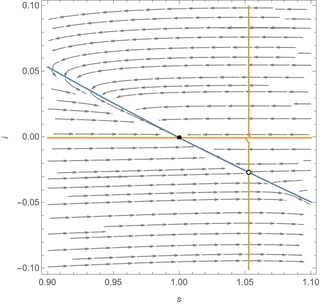(i)
Consider the system:
$$\frac{dS}{dt} =-\frac{\beta S I }{N}+ \gamma I$$ $$\frac{dI}{dt} = \frac{\beta S I }{N} - \gamma I$$
where $N=S+I$.
The equilibrium points being:
$$e_1:(S^*, I^*) = (N,0)$$ $$e_2:(S^*, I^*) = \left(\frac{\gamma N}{\beta}, \frac{N(\beta-\gamma)}{\beta} \right)$$
For simplicity we normalise $N$ to $1$.
The eigenvalues for $e_1$ (after substituting $e_1$ into the Jacobian) being:
$$ \lambda_1 =0,\\ \lambda_2 = \beta - \gamma.$$
The eigenvalues for $e_2$ (after substituting $e_2$ into the Jacobian) being:
$$\lambda_1 =0,\\ \lambda_2 = \gamma - \beta.$$
From the Jacobian we know $e_1$ is stable if $\beta < \gamma$ (or $R_0<1$) and unstable if $\beta>\gamma$ (or $R_0>1$).
Similarly for $e_2$ we see it is stable for $\beta > \gamma$ (or $R_0 > 1$) and unstable if $\beta<\gamma$ (or $R_0<1$).
How can we show these 4 plots where $R_0<1$ in one case and $R_0>1$ in another?
(ii)
$$\frac{dS}{dt}=-\frac{\beta S I}{N} + \xi R$$
$$\frac{dI}{dt}=\frac{\beta S I}{N} - \gamma I$$
$$\frac{dR}{dt}=\gamma I - \xi R$$
where $N=S+I+R$.
The equilibrium points being:
$$e_1 : (S^*,I^*, R^*) = \left(N, 0, 0 \right)$$ $$e_2 : (S^*, I^*, R^*) = \left(\frac{N\gamma}{\beta}, \frac{N\xi}{\gamma + \xi}\left(1- \frac{\gamma}{\beta}\right), \frac{N \gamma}{\gamma + \xi}\left(1-\frac{\gamma}{\beta} \right) \right)$$
The eigenvalues for $e_1$ (after substituting $e_1$ into the Jacobian) being:
$$\lambda_1 =0,\\ \lambda_2 = -\xi, \\ \lambda_3 = \beta- \gamma.$$
The eigenvalues for $e_2$ (after substituting $e_2$ into the Jacobian) being:
$$\lambda_1 =0,\\ \lambda_2 = \frac{-\xi\left(\beta +\xi\right) + \sqrt{\xi^2 \left(\beta +\xi\right)^2 -4\xi \left(\gamma+\xi\right)^2\left(\beta -\gamma\right)} }{2\left(\gamma + \xi\right)}, \\[2ex] \lambda_3 = \frac{-\xi\left(\beta +\xi\right) - \sqrt{\xi^2 \left(\beta +\xi\right)^2 -4\xi \left(\gamma+\xi\right)^2\left(\beta -\gamma\right)} }{2\left(\gamma + \xi\right)}.$$
Stability of $e_2$ has different cases, for different inputs $(\beta,\gamma$ and $\xi)$ we have three different stability points; a saddle point, a stable node, and a stable focus. How can we show this in a vector plot?
EDIT
Addendum (i)
Consider the system:
$$\frac{dS}{dt}=-\frac{\beta S I}{N}$$ $$\frac{dI}{dt}=\frac{\beta S I}{N}$$
where $N=S+I$.
The equilibrium points I have are:
$$e_1 : \left( S_1^*, I_1^*\right)= \left(N, 0\right), \\ e_2 : \left( S_1^*, I_1^*\right)= \left(0, N\right)$$
But this model is a little strange because I get an answer of (s,i) = (0,0) when I use your code.. any ideas why?
Addendum (ii)
$$\frac{dS}{dt}=\mu N -\frac{\beta S I}{N} -\nu S$$
$$\frac{dE}{dt}=\frac{\beta S I}{N} - \sigma E - \nu E$$
$$\frac{dI}{dt}=\sigma E -\nu I$$
where $N=S+E+I$ is the total population.
Using your code:
e := n - s - i;
SetModel[{Pop[
pop] -> {Component[
s] -> {Equation :> \[Mu] n - \[Beta] s i/n - \[Nu] s},
Component[i] -> {Equation :> \[Sigma] e - \[Nu] i}},
Parameters :> {\[Beta] > 0, \[Sigma] > 0, \[Mu] > 0, \[Nu] > 0,
n > 0}}]
eq = SolveEcoEq[]
gives:
{{s -> (n \[Nu]^2 + n \[Beta] \[Sigma] + n \[Nu] \[Sigma] -
Sqrt[-4 \[Beta] \[Sigma] (n^2 \[Mu] \[Nu] +
n^2 \[Mu] \[Sigma]) + (-n \[Nu]^2 - n \[Beta] \[Sigma] -
n \[Nu] \[Sigma])^2])/(2 \[Beta] \[Sigma]),
i -> (-((n \[Nu]^2)/\[Beta]) + n \[Sigma] - (
n \[Nu] \[Sigma])/\[Beta] +
Sqrt[-4 \[Beta] \[Sigma] (n^2 \[Mu] \[Nu] +
n^2 \[Mu] \[Sigma]) + (-n \[Nu]^2 - n \[Beta] \[Sigma] -
n \[Nu] \[Sigma])^2]/\[Beta])/(2 (\[Nu] + \[Sigma]))}, {s -> (
n \[Nu]^2 + n \[Beta] \[Sigma] + n \[Nu] \[Sigma] +
Sqrt[-4 \[Beta] \[Sigma] (n^2 \[Mu] \[Nu] +
n^2 \[Mu] \[Sigma]) + (-n \[Nu]^2 - n \[Beta] \[Sigma] -
n \[Nu] \[Sigma])^2])/(2 \[Beta] \[Sigma]),
i -> (-((n \[Nu]^2)/\[Beta]) + n \[Sigma] - (
n \[Nu] \[Sigma])/\[Beta] -
Sqrt[-4 \[Beta] \[Sigma] (n^2 \[Mu] \[Nu] +
n^2 \[Mu] \[Sigma]) + (-n \[Nu]^2 - n \[Beta] \[Sigma] -
n \[Nu] \[Sigma])^2]/\[Beta])/(2 (\[Nu] + \[Sigma]))}}
which seems incorrect as we don't have a disease-free equilibrium point. My equilibrium points were:
$$e_1 : \left( S_1^*, E_1^*, I_1^*\right)= \left(N, 0, 0\right), \\ e_2 : \left( S_2^*, E_2^*, I_2^*\right)= \left(\frac{N\nu\left(\sigma + \nu\right)}{\beta \sigma},\frac{N\nu^2 \left( \sigma + \nu \right) \left( \frac{\beta \sigma}{\nu\left(\sigma+\nu\right)} -1 \right) }{\beta\sigma\left(\sigma +\nu \right)} , \frac{N\nu\sigma \left( \sigma + \nu \right) \left( \frac{\beta \sigma}{\nu\left(\sigma+\nu\right)} -1 \right) }{\beta\sigma\left(\sigma +\nu \right)}\right)\\\\$$
The plot using the following:
\[Beta] = 0.6; \[Sigma] = 0.2; \[Mu] = 0.3; \[Nu] = 0.3; n = 1;
eq = SolveEcoEq[]
N[EcoEigenvalues[eq[[2]]]]
Show[PlotEcoPhasePlane[{s, 0, 1.6}, {i, -0.5, 1}],
RuleListPlot[eq, PlotMarkers -> EcoStableQ[eq]]]
And similarly
\[Beta] = 0.6; \[Sigma] = 0.4; \[Mu] = 0.2; \[Nu] = 0.2; n = 1;
eq = SolveEcoEq[]
N[EcoEigenvalues[eq[[2]]]]
Show[PlotEcoPhasePlane[{s, 0, 1}, {i, 0, 1}],
RuleListPlot[eq, PlotMarkers -> EcoStableQ[eq]]]
Addendum (iii)
$$\frac{dS}{dt}=\mu N -\frac{\beta S I}{N} + \gamma I -\nu S$$
$$\frac{dE}{dt}=\frac{\beta S I}{N} - \sigma E - \nu E$$
$$\frac{dI}{dt}=\sigma E - \gamma I -\nu I$$
where $N=S+E+I$ is the total population.
Using your code, we have:
e := n - s - i;
SetModel[{Pop[
pop] -> {Component[
s] -> {Equation :> \[Mu] n - \[Beta] s i/
n + \[Gamma] i - \[Nu] s},
Component[i] -> {Equation :> \[Sigma] e - \[Gamma] i - \[Nu] i}},
Parameters :> {\[Beta] > 0, \[Gamma] > 0, \[Sigma] > 0, \[Mu] >
0, \[Nu] > 0, n > 0}}]
eq = SolveEcoEq[]
giving:
{{s -> n, i -> 0}, {s -> (n \[Gamma])/\[Beta],
i -> -((n (-\[Beta] + \[Gamma]) \[Sigma])/(\[Beta] (\[Gamma] + \
\[Sigma])))}}
The first equilibrium point is correct however the second is wrong, from my results anyway. I get:
$$e_2 : \left( S_2^*, E_2^*, I_2^*\right)= \left(\frac{N \left(\gamma+\nu\right)\left(\sigma+\nu \right)}{\beta \sigma}, \frac{N\left(\gamma+\nu\right)^2\left(\sigma+\nu\right)}{\beta\sigma \left(\gamma + \sigma+\nu\right)}\left(\frac{\beta\sigma}{\left(\gamma+\nu\right)\left(\sigma+\nu\right)}-1\right), \frac{N\sigma\left(\gamma+\nu\right)\left(\sigma+\nu\right)}{\beta\sigma \left(\gamma + \sigma+\nu\right)}\left(\frac{\beta\sigma}{\left(\gamma+\nu\right)\left(\sigma+\nu\right)}-1\right)\right)\\[1ex]$$
Can you do what you did in your answer below for the addendum systems?












StreamPlot, particularly the Applications section $\endgroup$